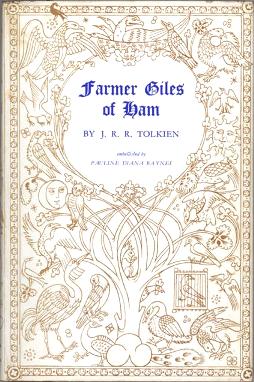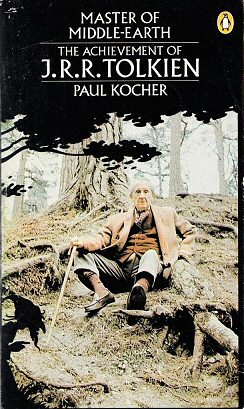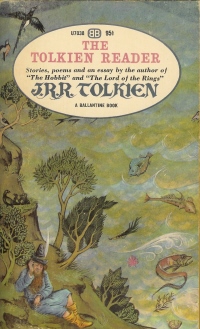
Farmer Giles of Ham is a comic medieval fable written by J. R. R. Tolkien in 1937 and published in 1949. The story describes the encounters between Farmer Giles and a wily dragon named Chrysophylax, and how Giles manages to use these to rise from humble beginnings to rival the king of the land. It is cheerfully anachronistic and light-hearted, set in Britain in an imaginary period of the Dark Ages. It features mythical creatures, medieval knights, and primitive firearms.

"Leaf by Niggle" is a short story written by J. R. R. Tolkien in 1938–39 and first published in the Dublin Review in January 1945. It was reprinted in Tolkien's book Tree and Leaf, and in several later collections. Contrary to Tolkien's claim that he despised allegory in any form, the story is an allegory of Tolkien's own creative process, and, to an extent, of his own life, following the structure of Dante's Purgatorio. It also expresses his philosophy of divine creation and human sub-creation. The story came to him in a dream.
"On Fairy-Stories" is an essay by J. R. R. Tolkien which discusses the fairy story as a literary form. It was written as a lecture entitled "Fairy Stories" for the Andrew Lang lecture at the University of St Andrews, Scotland, on 8 March 1939.
Goldberry is a character from the works of the author J. R. R. Tolkien. She first appeared in print in a 1934 poem, The Adventures of Tom Bombadil, where she appears as the wife of Tom Bombadil. Also known as the "River-woman's daughter", she is described as a beautiful, youthful woman with golden hair. She is best known from her appearance as a supporting character in Tolkien's high fantasy epic The Lord of the Rings, first published in 1954 and 1955.

Smith of Wootton Major, first published in 1967, is a novella by J. R. R. Tolkien. It tells the tale of a Great Cake, baked for the once in twenty-four year Feast of Good Children. The Master Cook, Nokes, hides some trinkets in the cake for the children to find; one is a star he found in an old spice box. A boy, Smith, swallows the star. On his tenth birthday the star appears on his forehead, and he starts to roam the Land of Faery. After twenty-four years the Feast comes around again, and Smith surrenders the star to Alf, the new Master Cook. Alf bakes the star into a new Great Cake for another child to find.

Tree and Leaf is a small book published in 1964, containing two works by J. R. R. Tolkien:

The Adventures of Tom Bombadil is a 1962 collection of poetry by J. R. R. Tolkien. The book contains 16 poems, two of which feature Tom Bombadil, a character encountered by Frodo Baggins in The Lord of the Rings. The rest of the poems are an assortment of bestiary verse and fairy tale rhyme. Three of the poems appear in The Lord of the Rings as well. The book is part of Tolkien's Middle-earth legendarium.
In J. R. R. Tolkien’s fictional universe of Middle-earth, the Old Forest was a daunting and ancient woodland just beyond the eastern borders of the Shire. Its first and main appearance in print was in the chapter of the 1954 The Fellowship of the Ring titled "The Old Forest". The hobbits of the Shire found the forest hostile and dangerous; the nearest, the Bucklanders, planted a great hedge to border the forest and cleared a strip of land next to it. A malign tree-spirit, Old Man Willow, grew beside the River Withywindle in the centre of the forest, controlling most of it.

"The Man in the Moon Stayed Up Too Late" is J. R. R. Tolkien's imagined original song behind the nursery rhyme "Hey Diddle Diddle ", invented by back-formation. It was first published in Yorkshire Poetry magazine in 1923, and was reused in extended form in the 1954–55 The Lord of the Rings as a song sung by Frodo Baggins in the Prancing Pony inn. The extended version was republished in the 1962 collection The Adventures of Tom Bombadil.
The following outline is provided as an overview of and topical guide to the real-world history and notable fictional elements of J. R. R. Tolkien's fantasy universe. It covers materials created by Tolkien; the works on his unpublished manuscripts, by his son Christopher Tolkien; and films, games and other media created by other people.
"Errantry" is a three-page poem by J.R.R. Tolkien, first published in The Oxford Magazine in 1933. It was included in revised and extended form in Tolkien's 1962 collection of short poems, The Adventures of Tom Bombadil. Donald Swann set the poem to music in his 1967 song cycle, The Road Goes Ever On.

The Homecoming of Beorhtnoth Beorhthelm's Son is a work by J. R. R. Tolkien originally published in 1953 in volume 6 of the scholarly journal Essays and Studies by Members of the English Association, and later republished in 1966 in The Tolkien Reader; it is also included in the most recent edition of Tree and Leaf. It is a work of historical fiction, inspired by the Old English poem The Battle of Maldon. It is written in the form of an alliterative poem, but is also a play, being mainly a dialogue between two characters in the aftermath of the Battle of Maldon. The work was accompanied by two essays, also by Tolkien, one before and one after the main work. The work, as published, was thus presented as:
This is a list of all published works of the English writer and philologist J. R. R. Tolkien. Tolkien's works were published before and after his death.
"The Sea-Bell" or "Frodos Dreme" is a poem with elaborate rhyme scheme and metre by J.R.R. Tolkien in his 1962 collection of verse The Adventures of Tom Bombadil. It was a revision of a 1934 poem called "Looney". The first-person narrative speaks of finding a white shell "like a sea-bell", and of being carried away to a strange and beautiful land.

In J. R. R. Tolkien's fantasy The Lord of the Rings, Old Man Willow is a malign tree-spirit of great age in Tom Bombadil's Old Forest, appearing physically as a large willow tree beside the River Withywindle, but spreading his influence throughout the forest. He is the first hostile character encountered by the Hobbits after they leave the Shire.
"Fastitocalon" is a medieval-style poem by J. R. R. Tolkien about a gigantic sea turtle. The setting is explicitly Middle-earth. The poem is included in The Adventures of Tom Bombadil.
The poetry in The Lord of the Rings consists of the poems and songs written by J. R. R. Tolkien, interspersed with the prose of his high fantasy novel of Middle-earth, The Lord of the Rings. The book contains over 60 pieces of verse of many kinds; some poems related to the book were published separately. Seven of Tolkien's songs, all but one from The Lord of the Rings, were made into a song-cycle, The Road Goes Ever On, set to music by Donald Swann. All the poems in The Lord of the Rings were set to music and published on CDs by The Tolkien Ensemble.

Trees play multiple roles in J. R. R. Tolkien's fantasy world of Middle-earth, some such as Old Man Willow indeed serving as characters in the plot. Both for Tolkien personally, and in his Middle-earth writings, caring about trees really mattered. Indeed, the Tolkien scholar Matthew Dickerson wrote "It would be difficult to overestimate the importance of trees in the writings of J. R. R. Tolkien."

Tolkien's Art: 'A Mythology for England' is a 1979 book of Tolkien scholarship by Jane Chance, writing then as Jane Chance Nitzsche. The book looks in turn at Tolkien's essays "On Fairy-Stories" and "Beowulf: The Monsters and the Critics"; The Hobbit; the fairy-stories "Leaf by Niggle" and "Smith of Wootton Major"; the minor works "Lay of Autrou and Itroun", "The Homecoming of Beorhtnoth", "Imram", and Farmer Giles of Ham; The Lord of the Rings; and very briefly in the concluding section, The Silmarillion. In 2001, a second edition extended all the chapters but still treated The Silmarillion, that Tolkien worked on throughout his life, as a sort of coda.

Master of Middle-earth: The Fiction of J. R. R. Tolkien, alternatively subtitled The Achievement of J.R.R. Tolkien, is a 1972 book of literary criticism of J. R. R. Tolkien's Middle-earth fantasy writings, written by Paul H. Kocher, and one of the few to be published in Tolkien's lifetime. It focuses especially on The Lord of the Rings and The Hobbit, and also covers some of his minor works such as "Leaf by Niggle" and "Smith of Wootton Major".













